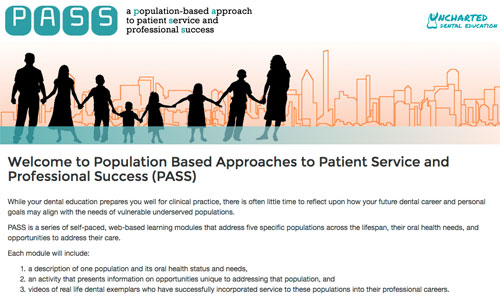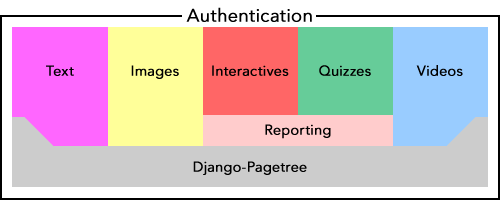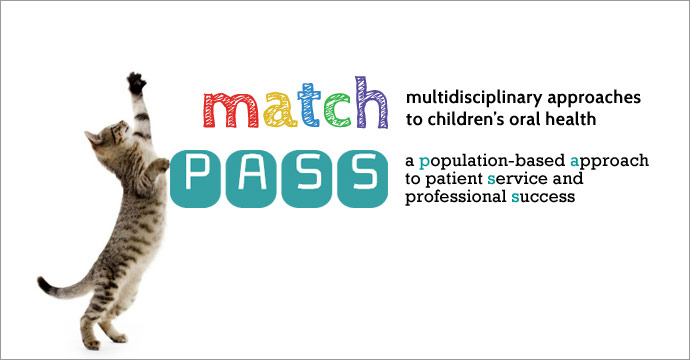This is the first of a three-part summary on the sustainability project of MATCH and PASS.
In 2011, the Center for Teaching and Learning (then Columbia Center for New Media Teaching and Learning (CCNMTL)) began collaborating with Drs. Burton Edelstein and Courtney Chinn of the Columbia University College of Dental Medicine (CDM) to develop two self-paced, web-based interactive learning environments, MATCH and PASS.

Multidisciplinary Approaches to Children’s Oral Health (MATCH) is a set of five training modules for practicing and future pediatric dentists to learn how they can work with other healthcare professionals to ensure a child’s oral health and overall well-being. Children’s oral health is determined by social, behavioral, genetic, nutritional, and educational factors—as well as by dental care. MATCH is an innovative effort to demonstrate how partnering with experts from these fields can enhance a dentist’s practice and help children and their families obtain the highest levels of oral health.

Population-Based Approach to Patient Service and Professional Success (PASS) is a series of learning modules designed to teach pre-doctoral dental students to consider patient populations and their oral health needs when deciding where and how to build a successful practice. PASS modules address five specific vulnerable populations, their oral health needs and options, and opportunities to address their care. Second-year students at CDM study the site as part of the Oral Health Care Delivery course.
Both projects provide learners with case studies, videos of exemplar interviews, quizzes, and rich JavaScript-based interactive activities designed to augment the online learning experience. MATCH and PASS were funded by a five-year grant respectively, beginning in 2011, from the Health Resources and Services Administration (HRSA) for the training of post- and pre-doctoral dentists.
MATCH and PASS were implemented in the CTL’s content management tool Pagetree. The Pagetree architecture is based on Django, a high-level Python Web framework, backed by a Postgres data store. The Pagetree infrastructure proved a powerful and cost-effective choice for these projects, and met several client requirements through an extensible infrastructure. Pagetree allowed for sequential page access, guiding the user through a scaffolded learning experience. The custom JavaScript interactives were designed and hooked in easily as each module implementation was unveiled.
The learning modules were placed behind Columbia and custom user authentication so that faculty clients could track students’ progress through the sites. Faculty could also download students’ responses to quizzes and activities for further assessment.

As these two projects reached the final year of the HRSA grant funding, the clients would like to keep the site content and interactives stateless, and publicly available to reach a broader audience, at minimum maintenance cost. The goal was not to redesign or re-envision the original pedagogical objectives of these projects, but rather to migrate these sites into an open ecosystem and make some amendments when necessary. The content will rarely be updated henceforth.
The sites will be offered as free and open educational resources through the TrainingFinder Real-time Affiliate Integrated Network (TRAIN) platform, or other LMS such as Canvas. In this new publicly open ecology, no user data will be collected and no reports will be generated in MATCH and PASS. All user assessment will be conducted within the LMS environments.
During this phase, we would explore ways to make the JavaScript interactive content modular, reusable, and stateless so that they can be embedded in other platforms such as blogs, wikis, LMS, and even MOOCs.
Moreover, the framework for this effort needed to be:
- a (server-side) static content infrastructure;
- a stable and sustainable framework;
- of minimal technology stack;
- low-maintenance and lightweight; and
- easily customized and updated.
With this new set of requirements towards sustainability came a new set of questions and challenges. We needed to address these issues before moving forward with implementation:
- What is “open”, and what are the corollaries of this “openness”?
- Is “openness” equivalent to “transparent”?
- How will this affect user stories?
- What is “static content”?
- What will be the extent of modularity for the JavaScript interactives and videos?
- How will student feedback change in this stateless environment?
- What will the hosting requirements be?
- What will be the binding copyrights and licensing of content and codes?
In the second part of this summary, “Migration Process ”, we’ll outline our efforts in shaping, mending, and migrating MATCH and PASS into their new digital adobe.
Printed from: https://compiled.ctl.columbia.edu/articles/match-pass-migration-01/

